The Reactive Arthritis Treatment Market is estimated to be valued at USD 742.1 million in 2025 and is projected to reach USD 1208.8 million by 2035, registering a compound annual growth rate (CAGR) of 5.0% over the forecast period.
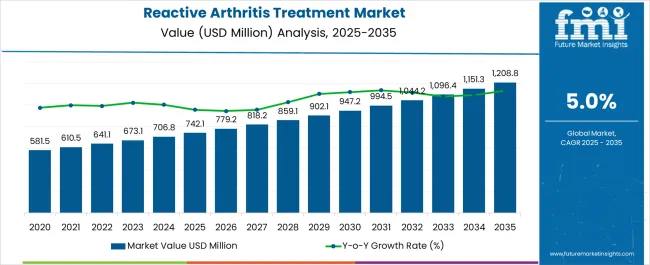
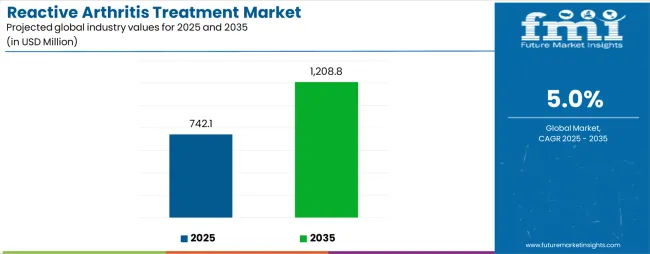
| Metric | Value |
|---|---|
| Reactive Arthritis Treatment Market Estimated Value in (2025 E) | USD 742.1 million |
| Reactive Arthritis Treatment Market Forecast Value in (2035 F) | USD 1208.8 million |
| Forecast CAGR (2025 to 2035) | 5.0% |
The Reactive Arthritis Treatment market is expanding steadily, supported by the growing prevalence of autoimmune and infection-triggered joint disorders. The condition, often associated with bacterial infections such as Chlamydia or gastrointestinal pathogens, requires comprehensive management strategies that combine antibiotics, anti-inflammatory drugs, and supportive therapies. Increasing awareness among healthcare professionals about early diagnosis and targeted treatment is driving market growth.
Rising incidence rates in both developed and emerging economies, coupled with lifestyle factors that contribute to weakened immunity, are further fueling demand. Innovations in drug development, including improved antibiotic formulations and biologics under clinical evaluation, are shaping future treatment pathways. Government initiatives aimed at strengthening infectious disease management and rheumatology care are reinforcing adoption across hospitals and clinics.
The growing availability of generic drugs has improved accessibility and affordability, supporting treatment uptake in cost-sensitive regions As patients increasingly seek effective and timely therapies to manage symptoms and prevent recurrence, the Reactive Arthritis Treatment market is expected to maintain consistent growth momentum over the coming years.
The reactive arthritis treatment market is segmented by drug type, route of administration, distribution channel, and geographic regions. By drug type, reactive arthritis treatment market is divided into Antibiotics, Corticosteroids, Nonsteroidal Anti-Inflammatory Drugs (NSAIDs), Disease Modifying Anti-Rheumatic Drugs (DMARDs), Tumor Necrosis Factor (TNF) Blockers, and Immunosuppressant Drugs. In terms of route of administration, reactive arthritis treatment market is classified into Oral, Topical/Transdermal, and Parenteral. Based on distribution channel, reactive arthritis treatment market is segmented into Hospital Pharmacies, Retail Pharmacies, and Online Pharmacies. Regionally, the reactive arthritis treatment industry is classified into North America, Latin America, Western Europe, Eastern Europe, Balkan & Baltic Countries, Russia & Belarus, Central Asia, East Asia, South Asia & Pacific, and the Middle East & Africa.
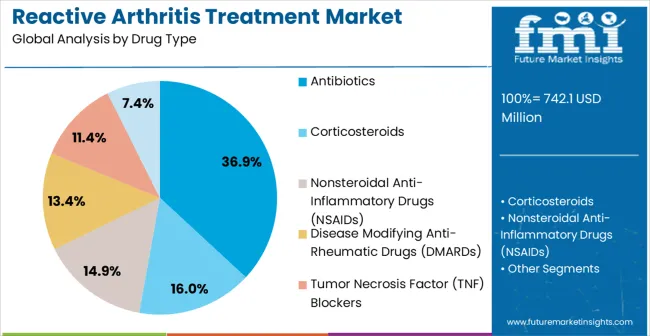
The antibiotics segment is projected to account for 36.9% of the Reactive Arthritis Treatment market revenue in 2025, positioning it as the leading drug type. Antibiotics play a critical role in addressing the underlying bacterial infections that trigger reactive arthritis, making them a cornerstone of treatment strategies. Their efficacy in reducing infection load helps to prevent long-term joint complications, thereby enhancing patient outcomes.
The availability of a wide range of oral and injectable antibiotic formulations ensures accessibility across diverse healthcare settings. Increasing prescription rates are also supported by the global rise in sexually transmitted and gastrointestinal infections, which are major triggers for this condition. Moreover, the growing use of generics has made antibiotic therapies more affordable, encouraging widespread adoption in low and middle-income regions.
Continuous improvements in formulations to reduce resistance and side effects further support their use As clinical guidelines emphasize timely antibiotic intervention for reactive arthritis, this segment is expected to retain its dominant position in the treatment landscape.
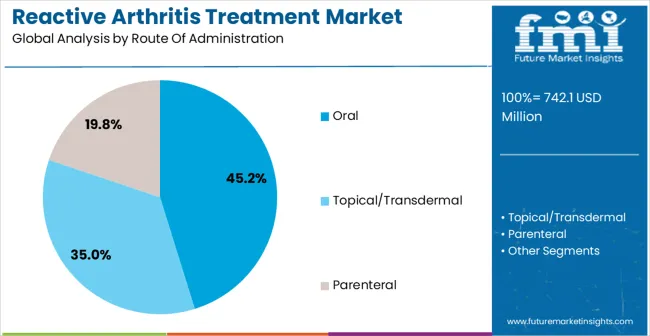
The oral route of administration segment is expected to capture 45.2% of the market revenue in 2025, making it the dominant method of delivering treatment for reactive arthritis. Oral drugs are highly preferred due to their ease of use, cost-effectiveness, and suitability for outpatient care. Patient compliance is significantly higher with oral medications compared to parenteral routes, which require clinical supervision.
The widespread availability of oral antibiotics and anti-inflammatory agents has reinforced this segment’s strong position in the market. Additionally, the oral route facilitates long-term therapy for patients managing chronic symptoms, which is critical for reducing flare-ups and maintaining quality of life. Pharmaceutical companies continue to invest in developing advanced oral formulations with improved bioavailability and reduced gastrointestinal side effects, further strengthening patient preference.
Growing demand for convenient and self-administered treatments across both developed and developing regions is expected to sustain this segment’s leadership With expanding access to pharmacies and online platforms, oral administration is anticipated to remain the preferred route in reactive arthritis treatment.
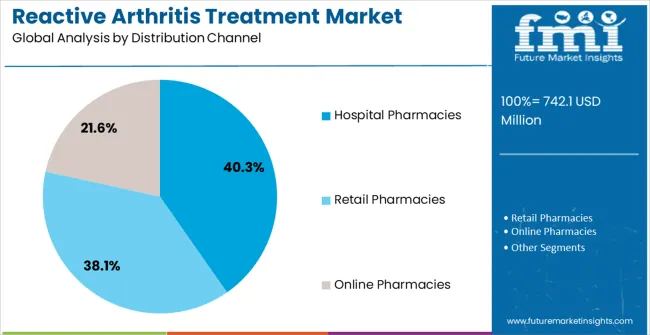
The hospital pharmacies segment is projected to hold 40.3% of the market revenue in 2025, emerging as the leading distribution channel for reactive arthritis treatments. Hospitals serve as the primary point of care for patients requiring diagnosis, advanced treatment, and management of complex cases. The availability of a wide range of medications, including antibiotics, anti-inflammatories, and biologics, ensures that hospital pharmacies remain the central hub for dispensing therapies.
Strong physician-pharmacist collaboration within hospital settings improves treatment adherence and ensures accurate medication management. Additionally, patients with severe infections or advanced stages of reactive arthritis often require hospital-based interventions, increasing reliance on hospital pharmacies. Government initiatives aimed at strengthening healthcare infrastructure and ensuring the availability of essential drugs further support this channel’s growth.
Hospital pharmacies also play a key role in maintaining compliance with safety standards and regulatory requirements, which enhances trust among patients As the burden of reactive arthritis rises and the demand for specialized care grows, hospital pharmacies are expected to sustain their dominance in the distribution landscape.
Reactive arthritis is a form of joint inflammation, which affects the joints, heels, toes, lower back especially of the knees and ankles, and may also affect the skin, urinary tract and eyes. Reactive arthritis belongs to a group of orthopedic disorders which is commonly known as spondyloarthritis, which can cause inflammation throughout the body, especially in the spine. Reactive arthritis occurs when a bacteria (Chlamydia trachomatis with Shigella, Salmonella, Campylobacter, Yersinia, or Clostridium difficile)
enters the blood stream from urogenital tract and gastrointestinal tract. There are few instances where the bacteria in urogenital tract can enter through vagina or urethra and spread over the bladder while in the gastrointestinal tract. Reactive arthritis typically initiates within 2 to 4 week after infection.
Reactive Arthritis can also create inflammation also can affect your eyes, skin, and urethra. As compared to men, women often have milder symptoms of reactive arthritis. Reactive arthritis usually tends to occur in men aged 40 and above. Reactive arthritis is not a contagious disease.
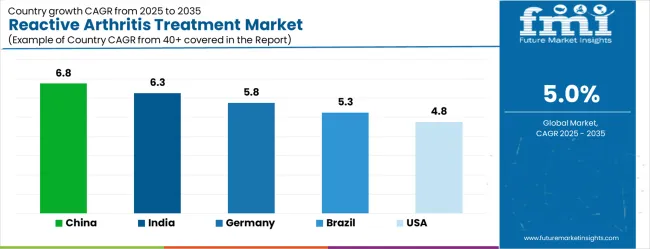
| Country | CAGR |
|---|---|
| China | 6.8% |
| India | 6.3% |
| Germany | 5.8% |
| Brazil | 5.3% |
| USA | 4.8% |
| UK | 4.3% |
| Japan | 3.8% |
The Reactive Arthritis Treatment Market is expected to register a CAGR of 5.0% during the forecast period, exhibiting varied country level momentum. China leads with the highest CAGR of 6.8%, followed by India at 6.3%. Developed markets such as Germany, France, and the UK continue to expand steadily, while the USA is likely to grow at consistent rates. Japan posts the lowest CAGR at 3.8%, yet still underscores a broadly positive trajectory for the global Reactive Arthritis Treatment Market. In 2024, Germany held a dominant revenue in the Western Europe market and is expected to grow with a CAGR of 5.8%. The USA Reactive Arthritis Treatment Market is estimated to be valued at USD 262.5 million in 2025 and is anticipated to reach a valuation of USD 262.5 million by 2035. Sales are projected to rise at a CAGR of 0.0% over the forecast period between 2025 and 2035. While Japan and South Korea markets are estimated to be valued at USD 40.5 million and USD 24.8 million respectively in 2025.
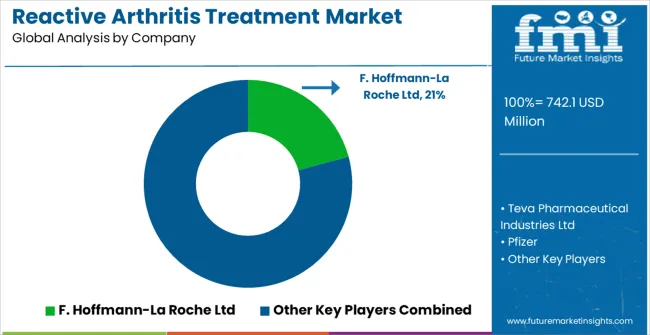
| Item | Value |
|---|---|
| Quantitative Units | USD 742.1 Million |
| Drug Type | Antibiotics, Corticosteroids, Nonsteroidal Anti-Inflammatory Drugs (NSAIDs), Disease Modifying Anti-Rheumatic Drugs (DMARDs), Tumor Necrosis Factor (TNF) Blockers, and Immunosuppressant Drugs |
| Route Of Administration | Oral, Topical/Transdermal, and Parenteral |
| Distribution Channel | Hospital Pharmacies, Retail Pharmacies, and Online Pharmacies |
| Regions Covered | North America, Europe, Asia-Pacific, Latin America, Middle East & Africa |
| Country Covered | United States, Canada, Germany, France, United Kingdom, China, Japan, India, Brazil, South Africa |
| Key Companies Profiled | F. Hoffmann-La Roche Ltd, Teva Pharmaceutical Industries Ltd, Pfizer, Novartis AG, Amgen Inc, Velcura Therapeutics, and Johnson & Johnson Services |
The global reactive arthritis treatment market is estimated to be valued at USD 742.1 million in 2025.
The market size for the reactive arthritis treatment market is projected to reach USD 1,208.8 million by 2035.
The reactive arthritis treatment market is expected to grow at a 5.0% CAGR between 2025 and 2035.
The key product types in reactive arthritis treatment market are antibiotics, corticosteroids, nonsteroidal anti-inflammatory drugs (nsaids), disease modifying anti-rheumatic drugs (dmards), tumor necrosis factor (tnf) blockers and immunosuppressant drugs.
In terms of route of administration, oral segment to command 45.2% share in the reactive arthritis treatment market in 2025.






Our Research Products

The "Full Research Suite" delivers actionable market intel, deep dives on markets or technologies, so clients act faster, cut risk, and unlock growth.

The Leaderboard benchmarks and ranks top vendors, classifying them as Established Leaders, Leading Challengers, or Disruptors & Challengers.

Locates where complements amplify value and substitutes erode it, forecasting net impact by horizon

We deliver granular, decision-grade intel: market sizing, 5-year forecasts, pricing, adoption, usage, revenue, and operational KPIs—plus competitor tracking, regulation, and value chains—across 60 countries broadly.

Spot the shifts before they hit your P&L. We track inflection points, adoption curves, pricing moves, and ecosystem plays to show where demand is heading, why it is changing, and what to do next across high-growth markets and disruptive tech

Real-time reads of user behavior. We track shifting priorities, perceptions of today’s and next-gen services, and provider experience, then pace how fast tech moves from trial to adoption, blending buyer, consumer, and channel inputs with social signals (#WhySwitch, #UX).

Partner with our analyst team to build a custom report designed around your business priorities. From analysing market trends to assessing competitors or crafting bespoke datasets, we tailor insights to your needs.
Supplier Intelligence
Discovery & Profiling
Capacity & Footprint
Performance & Risk
Compliance & Governance
Commercial Readiness
Who Supplies Whom
Scorecards & Shortlists
Playbooks & Docs
Category Intelligence
Definition & Scope
Demand & Use Cases
Cost Drivers
Market Structure
Supply Chain Map
Trade & Policy
Operating Norms
Deliverables
Buyer Intelligence
Account Basics
Spend & Scope
Procurement Model
Vendor Requirements
Terms & Policies
Entry Strategy
Pain Points & Triggers
Outputs
Pricing Analysis
Benchmarks
Trends
Should-Cost
Indexation
Landed Cost
Commercial Terms
Deliverables
Brand Analysis
Positioning & Value Prop
Share & Presence
Customer Evidence
Go-to-Market
Digital & Reputation
Compliance & Trust
KPIs & Gaps
Outputs
Full Research Suite comprises of:
Market outlook & trends analysis
Interviews & case studies
Strategic recommendations
Vendor profiles & capabilities analysis
5-year forecasts
8 regions and 60+ country-level data splits
Market segment data splits
12 months of continuous data updates
DELIVERED AS:
PDF EXCEL ONLINE
Canine Arthritis Treatment Market Forecast and Outlook 2025 to 2035
Rheumatoid Arthritis Treatment Market
Psoriatic Arthritis (PsA) Treatment Market Insights – Growth & Forecast 2024-2034
Reactive Brominated Flame Retardants Market Size and Share Forecast Outlook 2025 to 2035
Reactive Hot Melt Adhesive Market Forecast Outlook 2025 to 2035
Reactive Tire Bladder Release Agent Market Size and Share Forecast Outlook 2025 to 2035
Treatment-Resistant Hypertension Management Market Size and Share Forecast Outlook 2025 to 2035
Treatment-Resistant Depression Treatment Market Size and Share Forecast Outlook 2025 to 2035
Treatment Pumps Market Insights Growth & Demand Forecast 2025 to 2035
Reactive Diluents Market Growth – Trends & Forecast 2022 to 2032
Reactive Softeners (Textile Industry) Market
C-Reactive Protein Analyzers Market
Pretreatment Coatings Market Size and Share Forecast Outlook 2025 to 2035
Air Treatment Ozone Generator Market Size and Share Forecast Outlook 2025 to 2035
CNS Treatment and Therapy Market Insights - Trends & Growth Forecast 2025 to 2035
Seed Treatment Materials Market Size and Share Forecast Outlook 2025 to 2035
Acne Treatment Solutions Market Size and Share Forecast Outlook 2025 to 2035
Scar Treatment Market Overview - Growth & Demand Forecast 2025 to 2035
Osteoarthritis Gene Therapy Market
Soil Treatment Chemicals Market

Thank you!
You will receive an email from our Business Development Manager. Please be sure to check your SPAM/JUNK folder too.
Chat With
MaRIA